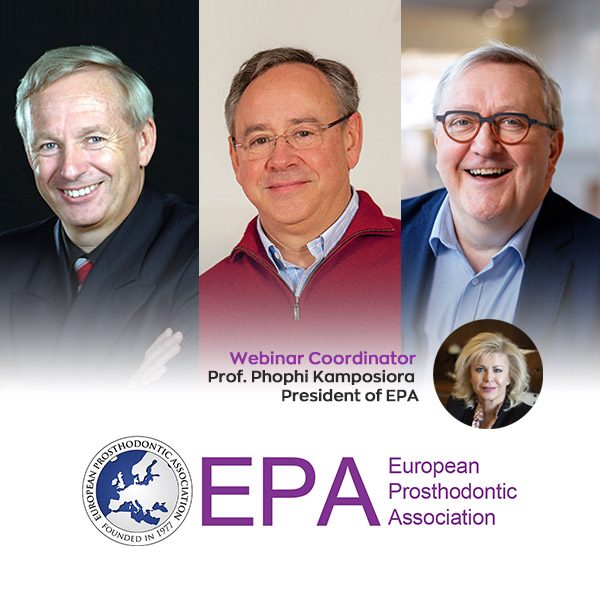Webinar Competed

Date:
Saturday
,
08
May
,
2021
Time:
12:00 pm- 01:30pm CET (Central European Time)
Duration:
90 min
Language:
English
Speakers
Organized by:
Certified Hours:

WEBINAR ANALYSIS
Webinar Coordinator: Prof. Phophi Kamposiora President of EPA
Lecture: Adopting wisely innovative computer-assisted technologies in prosthodontic care
Prof. Asbjørn Jokstad
Computer-assisted technologies in dentistry continue to evolve rapidly. Data exchange between digital devices enables professionals to adopt different CA-tracking and recording devices and CA design solutions. New additive and subtractive processing devices facilitate CA manufacturing across national borders. Today, professionals can choose amongst multiple sophisticated digital technologies for diagnostic purposes or customize dental devices, restorations, implant system components, scaffolds for tissue engineering, and oro-maxillo-facial prostheses. As prosthodontists, we need to adapt and assimilate the best digital technologies and recognize the strengths, weaknesses, benefits, and challenges of the current spectrum of digital technologies and a new generation of biomaterials suited for CAM that largely remain untested clinically. An essential question is whether we have prepared wisely to be or not to be prosthodontists of the future.
Lecture: Implant treatment when bone is lacking
Prof. Hugo de Bruyn
Over the last 50 years implant dentistry has evolved tremendously. Clinical outcome has become more predictable in more patients with various treatment indications thanks to modified macroscopic and microscopic implant features in addition to improved presurgical diagnostics. Better understanding of the biology of bone and surgical bone and soft tissue grafting techniques, with or without use of biomaterials, created opportunities to improve function as well as aesthetics. However, when bone volume is lacking often additional surgical bone grafting interventions may be required. In addition non-ideally placed implants required prosthetic compromises often hampering esthetics as well cost-effectiveness. Non-standardized implant placement has serious financial drawbacks, increases morbidity and risk for complications whereby in the end more often only the happy few can afford implant-retained restorations.
This is especially the case for millions of patients suffering from complete tooth loss and burdened with denture wearing. Edentulous patients often report dysfunctional mastication, retention issues with the denture, lower self-esteem and aesthetic concerns resulting in a reduced oral health-related quality of life. This lecture will propose alternatives to bone grafting and focus on the use of dental implants in patients where years of denture wearing compromised the bone volume and hampers conventional implant placement, especially in the maxilla. Simplified treatment protocols as compared to extensive bone grafting are demonstrated based on 5 years clinical research data including patient-centered outcome measures.
Lecture: Biofilm – biomaterial interactions
Prof. Mariano Sanz
Periodontal and peri-implant diseases are inflammatory conditions driven by the accumulation and maturation of biofilms on dental and implant surfaces. Research on the interactions between Biofilms and different implant and restorative surfaces have shown the impact that these macro and micro surface characteristics may have on the pathogenic potential of these microbial communities. During this presentation, the scientific evidence on the importance of these bacterial biomaterial interactions will be shown through a series of in vitro and clinical research studies carried out by our research group. Special emphasis will be placed on the development of in vitro biofilm models able to study not only the differences in bacterial growth and maturation on different surfaces, but also the efficacy of different antimicrobial strategies when applied to different surfaces. Clinical research focused on the design of implant supported restorations on biofilm accumulation and disease occurrence will be presented.